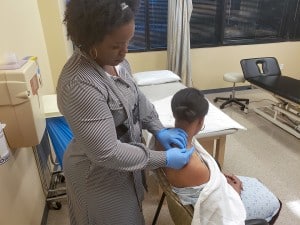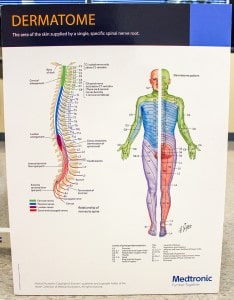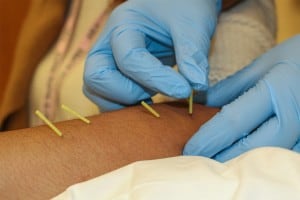A new technique can soothe muscle pain, ease migraines, speed recovery and more – and our Center for Rehabilitative Medicine at the East Campus is one of just a handful of local providers offering it to patients.
But what exactly is Dry Needling, and who can it help? How does it work? And, given that it does involve needles, does it hurt?

Ambrosia Scott offers Dry Needling at the Center for Rehabilitative Medicine. It can help with pain from head to toe.
Ambrosia Scott, DPT, LAT, CCI, Outpatient Rehabilitation Manager for Regional One Health, has the answers.
Scott, who offers Dry Needling as part of the physical therapy program, talked about the technique that mixes acupuncture, trigger point therapy and neuroanatomy.
How do I know if Dry Needling will help me?
Start by scheduling an evaluation with a physical therapist, who will create an overall treatment plan. The therapist can recommend Dry Needling if they believe it would help.
Scott noted, “We still need to address how the pain came about. Physical therapy is important, or it becomes a recurring cycle.”
Appointments are available both with a doctor’s referral and through Direct Access, which lets patients with private insurance or who are paying out of pocket make their own appointment.
Which patients benefit from Dry Needling?
“It works for a lot of diagnoses,” Scott said. “It can be used for any age group – the worker who does repetitive tasks to the weekend warrior athlete to the geriatric patient who isn’t able to move as much as they used to.”

Ambrosia Scott prepares a patient for a Dry Needling Session, which can help with pain relief and muscle relaxation.
Those patients can experience micro-trauma to the joints and muscles, causing pain and injury.
Dry Needling can be used almost anywhere on the body, from the face and head to the soles of the feet, and has very few contraindications, save for not being appropriate for patients with a bleeding disorder, communicable disease or nickel allergy.
It can help with TMJ, migraines, muscle spasms or tightness, overuse injuries, neurological issues, back and neck pain and more.
It can even be used prior to athletic competition to increase blood flow to a certain area – similar to “cupping,” which gained attention during the 2016 Summer Olympics.
What happens during Dry Needling therapy, and does it hurt?
Therapists start by consulting with the patient on treatment preferences.
“Our needles are very thin needles, but it is a needle sticking in the body. You do feel it, but they’re not there to cause pain,” Scott said. “We first test patients’ sensitivity to pressure, and we always explain the process to make them less anxious. Then, we continuously communicate with the patient to make sure they’re comfortable.”
A session may last five to 15 minutes, and the number needed will vary.
Some patients tell Scott they don’t even feel the needles going in, and others experience immediate relief or relaxation, as the technique releases muscle tension. Some feel a little soreness afterwards, which is normal.
Why does it work?

Physical therapists at the East Campus are experts in neuroanatomy, which is key to effective Dry Needling treatments.
Dry Needling creates a small lesion where the patient is suffering pain, signaling the body to increase circulation to the area and draw white blood cells and plasma cells to the injury.
“The body is remarkable, because it’s going to naturally start the healing process,” Scott said.
“Dry Needling stimulates a response for the body to heal itself.”
Why should I use the East Campus for Dry Needling?
It’s important to find the right provider, and the Center for Rehabilitative Medicine is unique in that Dry Needling is done by clinicians in a hospital setting, ensuring trust and expertise.
All physical therapists at the East Campus have their doctorate, Scott added:
“Our training includes a strong focus on the entire body. We know how the body works, and we know the neuroanatomy to support the process. It is part of what we do every day.”
